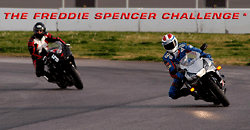
|
|
||||||||
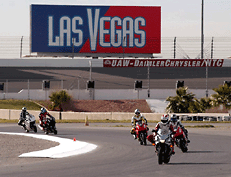 |
| Just in case you forget where you are. |
Bugger, I’m going to mess this one up for sure.
Although I was momentarily experiencing sensory overload, riding a Honda F4 at the Las Vegas Motor Speedway in the middle of January was proving to be a welcome change from the minus forty degree enforced hibernation back home in Montreal.
No two ways about it, for motorcyclists, winters in Canada suck. Not only do you have to put up with shite weather, but you also suffer motorcycle withdrawal in the process. Then comes spring, when you finally hit the open road only to wobble around the first technical corner like a retarded newbie.
Okay, so within a month you’re back in the grove and riding like a pro, but there’s a way to avoid not just the slow reaquaintance process to two wheels, but to get that all important moto-fix in the middle of winter to boot.
GO SOUTH YOUNG MAN!
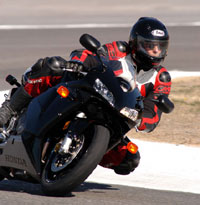 |
| Finding yourself on a track testing Honda's CBR600RR in the middle of January is one of life's high points. |
In mid January last year I found myself at a special one-day course of the Freddie Spencer school, courtesy of Honda Canada, who were supplying the flock of Canadian journalists present with a free day at said school as part of their annual product launch.
Maybe Honda have got wise to the risk of slapping a load of rusty journos on a track with their latest and greatest, only to count away the minutes for the inevitable lowside and shattered bodywork as testosterone and ego unfold to their ultimate conclusion. Putting us all through the school first was clever. Making us believe that we were being spoilt rotten (and not really being shown how to ride without crashing) was pure genius.
But what do you exactly get at one of these riding schools? Surely it’s not twenty hours of tedium in the classroom followed by a few laps and a piece of paper saying “I did the Freddie Spencer School and all I got was this lousy certificate”.
Thankfully not, but good question.
BACK TO SCHOOL
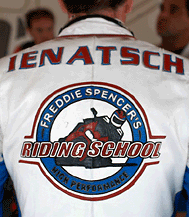 |
| It's as if somebody got drunk and then pulled out a game of Scrabble. |
I’m not good in the morning.
Nick (if that’s his real name) sets the ground rules, “If you crash you’re done.” Simple really. Herr Ienatsch does go on to point out that this track has plenty of run-off room, so please feel free to use it if you’re getting into trouble.
He concludes that crashes happen because of lack of concentration, jumping on the throttle/brakes, rushing the corner entrance or repeating the same mistake - and adding more speed to it each time. Basically pay attention and be smooth by being easy on the throttle and brakes and avoiding abruptness.
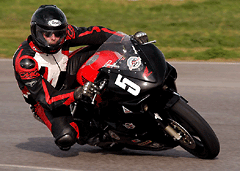 |
| Good positioning with a slight tug on the front brake. Sometimes it all just comes together. |
At this point Freddie himself takes control and goes over positioning yourself on the bike and – one of Freddie’s personal favourite techniques – Trail Braking. Okay, I’ve heard about it, I may even have feigned knowledge about it, but it was new to me in a race track situation.
The theory is that you enter a corner with a very slight drag still on the front brake (3-4% pressure). This allows for:
1) Better directional control by slightly compressing the front suspension. Think about it, grabbing a handful of brake just before the corner and then letting it go as you start the turn releases the loading on the front springs and causes the front to extend. Keep it on a tad as you enter said turn and you go in with a steeper steering angle for sharper steering and a more settled bike to boot. And …2) The luxury of applying additional braking mid-corner without upsetting the bike’s posture (more on this later).
 |
| Nick gives the commentary while the assembled mob look on in morbid fascination as Jeff does stuff that shouldn't be possible on a bike. |
The standard courses consist of a mixture of classroom theory followed by the practicing of said theory out on the track. Fortunately, they use the inner (and most interesting) part of the L.V. Motor Speedway – a lovely combination of nine corners and a long straight. This is encircled by a large oval, around which a whole bevy of V-8 Nascar vehicles periodically droned around in a seemingly endless loop. However, this can prove to be a bit of a distraction, forcing our instructors to use P.A.s so that they could be heard by the group a few feet in front of them.
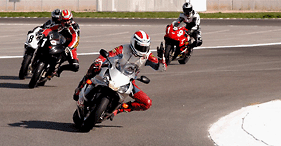 |
| On track instruction is done through hand signals. |
Other topics include riding through a corner as fast and safely as possible, the most efficient body positioning, weight shifting (don't forget to drop your 40lb head into the corner!), fine usage of throttle and brakes, down-shifting and, most painful of all, analysis of your bad habits.
All the time that you’re on the track, the instructors are watching you and making mental notes. Once you pull into the pits, they’ll go over some ideas with you so that you can go back out and try them. If they’re on the track with you, then they’ll often follow you for a while, take the lead, and then – using hand signals – show you what you’re doing wrong.
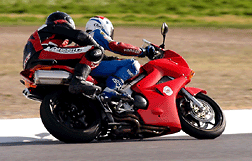 |
| This is the moment that I realized I had to buy my borrowed leathers - Freddie shows me how it's done (riding that is). |
Manliness is secured by placing both your hands on the front of the tank and not around Freddie, enabling self-control during braking, but the need for utter faith during acceleration. On the occasions that I kept my eyes open, perfect lines unfolded before me. Apexes were being clipped and corner entries and exits were taken with fractions of an inch of track to spare. And all with a smoothness that only a self-assured champion could do. It was awesome, but I’m not sure I really wanted to know just how crap I actually am.
A LESSON LEARNED
 |
| Being followed and filmed can be a tad disconcerting. |
Nick did a very good job of keeping a straight face as he tried to find good things to say. “Uh, hmmhh, corner one … you’ll crash if you keep doing that”. Hey, all I saw was a big looming shadow as Jeff zoomed up to me to film my ‘progress’. I was waiting to be passed mid-corner, not trying to get the perfect line, dammit.
They didn’t buy it and the rest of my pitiful lap saw me veer off from one side of the screen to the other - as any rider would do when he finally realized that he wasn’t actually about to be passed for the last four corners, but was in fact being filmed to be shown to a class full of his hyenic peers.
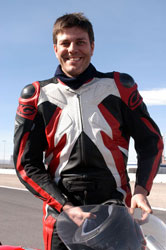 |
| Come to think of it, my life is pretty good. |
So what did I learn? Well apart from discovering that I don’t ride well when filmed and after a day on the track my legs stop working, plenty.
Maybe the most useful came on a recent tour of Pennsylvania on Yamaha’s loverly FJR1300. Coming into a corner too hot and cranked over as far as I dared I had no choice but to scrub off some of the speed with the front brake. Trail braking had become instinctive, allowing me to keep applying the pressure without so much as a by your leave from the FJR. Getting the ABS to pulse with no drifting from the bike in the process not only says a lot about the bike, but also for trail braking.
Once I’d had time to change my pants I was full of praise of all things Freddie Spencer.
THE VITALS
The Freddie Spencer High Performance School is geared to street riders with the goal of giving you more control of the bike and increased confidence.
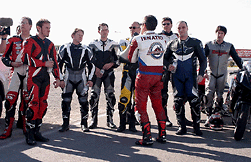 |
| A sad bunch really ... |
For mere mortals (that’s you btw), courses come in two or three day stints with a relatively hefty price tag in the upper two grand (US) range. But where else do you get to hang out with a three-time world champion, ask for some riding tips and then soil yer pants as said world champion takes you for a lap on the back of his VFR? Hell, throw in a rental bike and a week’s ride in the area (Las Vegas is the perfect launching point for such a trip btw) and you have a mid-winter riding experience that’s sure to keep you smiling till spring.
Although equipment is available for rent, it’s always best to try and bring your own so that you’re not concentrating on how the leathers pinch yer generals every time you hit the chicane instead of the chicane itself. Oh, and bring some good wicking underwear as it can get pretty damn hot and sweaty.
Courses run from October to June and come in Sport/Street Rider level I and II, Pro School and Women Only formats. For more info go to www.fastfreddie.com.
Thanks to Honda Canada for making this happen and to Freddie, Nick and Jeff, who proved to be not only incredibly patient with us all, but also modest, attentive and courteous.
THE CMG GUIDE TO US TRACK SCHOOLS:
Freddie Spencer’s
High Performance School
Las Vegas, Nevada
1-888-672-7219
www.fastfreddie.com
C.L.A.S.S
Santa Paula, California
1-805-933-9936
www.classrides.com
Keith Code’s
California Superbike School
Glandale, California
1-818-841-7661
www.superbikeschool.com
Kevin Schwantz Suzuki
School
Braselton, Georgia
1-800-849-7223
www.schwantzschool.com
Star Superbike School
Ventura, California
1-805-658-6333
www.starmotorcycle.com
![]()